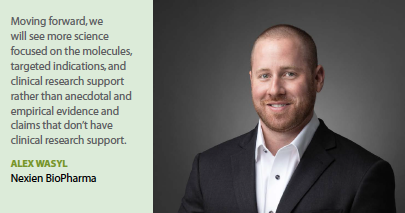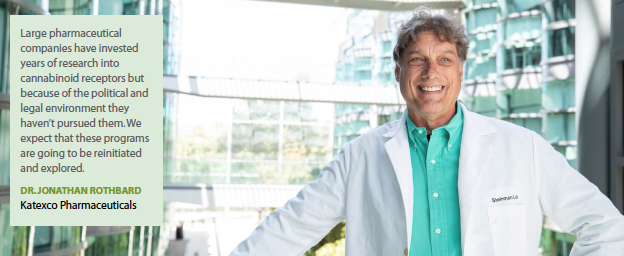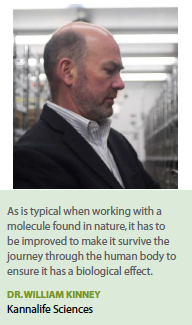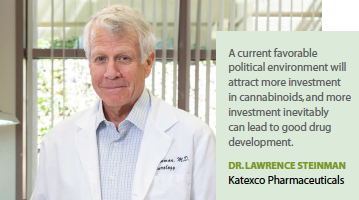Cannabis has remained a source of controversy — from debates on its medicinal value and legalization to concerns about dependency. Cannabis is a hot-button issue among patients, healthcare practitioners, and policymakers. But that is changing.
In fact, 32 states and Washington, D.C., now allow marijuana to be prescribed for medical purposes, although their approaches differ. Some states allow medical marijuana dispensaries and some allow for home cultivation.
“The perception and stigma associated with cannabis is changing from a societal standpoint," says Jessica  Rousset, chief operating officer of CURE Pharmaceutical. “People are talking about their experiences and challenging their physicians and bringing the benefits of cannabis to light. This is a sea change."
Rousset, chief operating officer of CURE Pharmaceutical. “People are talking about their experiences and challenging their physicians and bringing the benefits of cannabis to light. This is a sea change."
As a result of these and other changes in the field, the global medical cannabis market is projected to grow at a compound annual growth rate (CAGR) of 24.4% and surpass $20.17 billion by 2025, according to Coherent Market Insights.
“Cannabis has been used in humans for centuries, and it has an extraordinarily good safety profile," says Jonathan Rothbard, Ph.D., CEO, chief scientific officer and co-founder of Katexco Pharmaceuticals. “Segregation of the different activities of the plant to distinguish anti-inflammatory effects from the psychotropic effects, would be an important result. And researchers are starting to do this."
The U.S. approval of Epidiolex in June 2018 — the first plant-based cannabinoid to be approved by the FDA — is viewed as a huge shift forward for the science surrounding cannabis, providing a pathway for other cannabinoid-based drugs to come to the market.
In fact, industry experts say the approval of GW Pharmaceuticals’ Epidiolex for the treatment of seizures associated with two rare forms of epilepsy will likely encourage other companies to maximize the opportunity of developing new drugs in this class.
“The medical marijuana industry has grown so much that now true science and research under federally sanctioned protocols is increasing," says Alex Wasyl, CEO of Nexien BioPharma. “Research has largely been restricted to date due to cannabinoids being Schedule I. As more people recognize the therapeutic potential of these molecules, DEA licensed parties such as formulation labs, CDMOs, and academic labs are increasingly interested in participating in innovation."
Moving forward, he says, we will see more science focused on the molecules, targeted indications, and clinical research support rather than anecdotal and empirical evidence and claims that don’t have clinical research support.
“Much of the anecdotal and empirical claims are a result of the state sanctioned ‘medical marijuana industry,’ " Mr. Wasyl says.
New companies, such as Katexco and Nexien, are using a growing knowledge base about cannabinoids.
The current political and legal environment, which is more favorable toward cannabis, is helping to spur research, Dr. Rothbard says.
“Large pharmaceutical companies have invested years of research into cannabinoid receptors, but because  of the political and legal environment they haven’t pursued them," he says. “We expect those programs to be reinitiated and explored."
of the political and legal environment they haven’t pursued them," he says. “We expect those programs to be reinitiated and explored."
Breaking Down the Plant
The marijuana plant contains more than 100 cannabinoids. The body also produces its own cannabinoid chemicals. They play a role in regulating pleasure, memory, thinking, concentration, body movement, awareness of time, appetite, pain, and the senses.
Currently, the two main cannabinoids from the marijuana plant that are of medical interest are THC and CBD. THC can increase appetite and reduce nausea. THC may also decrease pain, inflammation (swelling and redness), and muscle control problems.
Unlike THC, CBD is a cannabinoid that doesn’t make people high and may be useful in reducing pain and inflammation, controlling epileptic seizures, and possibly even treating mental illness and addictions.
The first cannabinoid receptor was discovered in the late 1980s, and in the early 1990s, a second cannabinoid receptor was found. Cannabinoid receptors include CB1, which is predominantly expressed in the brain, and CB2, which is primarily found on the cells of the immune system. The fact that both CB1 and CB2 receptors have been found on immune cells suggests that cannabinoids play an important role in the regulation of the immune system.
There are 60 companies currently involved in the development of cannabinoid receptor agonists, according to Datamonitor. Companies are developing cannabinoids for 92 indications, ranging from  epilepsy to glaucoma. Cannabinoids may be amenable to treating an array of diseases as they interact with the human endocannabinoid system.
epilepsy to glaucoma. Cannabinoids may be amenable to treating an array of diseases as they interact with the human endocannabinoid system.
Almost a third of these companies are involved in the development of more than one cannabinoid drug. Datamonitor finds the bulk of investigated indications are pain-related, with the top two most investigated indications being neuropathic pain and nociceptive pain.
A Patient-Driven Movement
Mr. Wasyl says patients are demanding new research and development of cannabinoid therapies.
“The entire medical marijuana movement has initiated further interest from researchers who have been doing their own internal investigations on cannabinoids," he says. “There is untapped therapeutic potential in these compounds, which will be valuable in ways not currently recognized due to the lack of research. A growing number of academic institutions and private institutions are progressing with research. We are entering the market at a very good time."
Nexien BioPharma has begun an open label patient case study of the use of advanced sublingual cannabinoid-based formulations for the treatment of myotonic dystrophy (DM) and myotonia, an autosomal dominant transmitted genetic disorder that can affect all parts of the body, but predominantly affects muscular function.
Nexien has also announced a research collaboration with an Ivy League university medical school neurology lab for preclinical animal studies. In these studies, Nexien will be investigating their advanced fast-acting parenteral formulations for refractory epilepsy, which is a type of epilepsy that does not respond to currently available medications. Up to 1 in 3 people with epilepsy have what can be considered refractory epilepsy.
Mr. Wasyl says the company’s IP portfolio also consists of patents for the use of cannabinoid formulations in treating nerve agent exposure, chronic traumatic encephalopathy (CTE), targeted pain indications, and others.
Steve Schultz, VP of investor relations and a spokesperson for GW Pharmaceuticals, says his company’s two approved therapies, which were formulated from plant-based cannabis, were driven by patients and caregivers looking for alternative treatments.
 “Patients and parents of young patients came to us wanting a pharmaceutical formulation of purified CBD that has the hallmarks of a modern medicine," he says.
“Patients and parents of young patients came to us wanting a pharmaceutical formulation of purified CBD that has the hallmarks of a modern medicine," he says.
Mr. Schultz adds that parents of children with rare epilepsy were trying different cannabinoid oils, raw cannabis, and herbal supplementation, and were getting various degrees of relief from seizures.
“These parents were doing a significant amount of research on the subject and were coming across data that were generated from GW’s preclinical program," he says. “They were bringing these data to their physicians and their epilepsy specialists."
The Epidiolex program, which started with a single patient on a compassionate use basis, has grown to more than 2,000 patients both in the company’s compassionate use program and in pivotal studies of Epidiolex.
Epidiolex is a liquid pharmaceutical formulation of pure plant-derived cannabidiol (CBD), a cannabinoid present in marijuana. The drug is the first pharmaceutical approved in the United States of a formulation derived from marijuana and the first in a new category of anti-epileptic drugs.
In June 2018, GW received U.S. approval of Epidiolex (cannabidiol) oral solution for the treatment of seizures associated with two rare and severe forms of epilepsy, Lennox-Gastaut syndrome, and Dravet syndrome, in patients 2 years old and older.
The Department of Justice and Drug Enforcement Administration in September placed Epidiolex in Schedule V of the Controlled Substances Act, the least restrictive schedule due to its low abuse potential. GW launched Epidiolex in November.
Despite Epidiolex’s niche positioning for rare pediatric epilepsies, Datamonitor Healthcare forecasts strong sales potential, with a peak of $822 million in 2025.
Epidiolex was GW’s second product. The first was Sativex (nabiximols), approved for the treatment of spasticity due to multiple sclerosis (MS) in numerous countries outside the United States. The company is now planning a U.S. Phase III trial.
British patients with MS were treating their spasticity with artisanal herbal marijuana but they were realizing various degrees of relief because the raw plant doesn’t offer consistency or characterization for its safety or efficacy.
“Our founder Dr. Geoffrey Guy was able to obtain a license to grow and formulate a pharmaceutical cannabinoid-based medicine and do the clinical work for the treatment of spasticity due to MS," Mr. Schultz says. “That clinical program was supported by three successful Phase III pivotal studies and has resulted in more than 25 approvals outside of the United States."
The company continues to research both products. In November, the company announced positive top-line results of the second randomized, double-blind, placebo-controlled Phase III clinical trial of Epidiolex for the treatment of seizures associated with Dravet syndrome. In this trial, Epidiolex, when added to the patient’s current treatment, achieved the primary endpoint of reduction in convulsive seizures for both dose levels. Dravet syndrome is a severe infantile-onset and highly treatment-resistant epileptic encephalopathy frequently associated with genetic mutations in the SCN1A sodium channels.
The company is conducting research of Epidiolex for tuberous sclerosis complex, a condition where tumors grow in the patient’s brain and cause refractory seizures. The results of a single Phase III study in this condition are expected in the first half of 2019, and if successful the company will submit an sNDA to expand the Epidiolex label.
In addition, GW plans to begin research of Epidiolex in autism spectrum disorders, initially focusing on a condition called Rett Syndrome, which affects mainly young girls.
Beyond, Sativex and Epidiolex, GW is evaluating another compound, CBDv, which is very similar to CBD, for autism, beginning with an open label evaluation, as well as compounds for gliobastoma and schizophrenia.
Another such company researching innovative ways to deliver cannabis-based therapies is CURE Pharmaceutical, which has secured a new registration with the Drug Enforcement Administration as a manufacturer authorized to handle Schedule 1 controlled substances. With this license, CURE will develop and manufacture cannabinoid-based pharmaceutical products using its CUREfilm technology.
“The technology is similar to a Listerine breath freshener, which is a stamp-sized film that you put on your tongue and it dissolves fairly quickly," Ms. Rousset says. “We have a more sophisticated version of the technology in which we can put different active ingredients. We focus on small molecules although there is certainly a potential for larger molecules such as insulin. We are focusing on small molecules that are poorly absorbed by the body."
Ms. Rousset says early on CURE started looking at cannabinoids because of family and friends’ personal experiences with cannabis. “These molecules hold a tremendous amount of therapeutic promise but there needs to be more research," she says. “We also realized these molecules fall into our sweet spot: a category of drugs that are poorly soluble or have limited absorption by the body. It was a logical place to apply our technology."
CURE works with cannabinoids that are synthesized clinically to isolate specific molecules from cannabis, such as THC or CBD. “We can work with whole plant extracts and put those on the film," she says.
 Cure has a license agreement with Canopy Growth, a Canadian cannabis company, to take their plant extracts for products to market in many different segments and indications. Ms. Rousset says the companies are looking at CNS and inflammation-related indications.
Cure has a license agreement with Canopy Growth, a Canadian cannabis company, to take their plant extracts for products to market in many different segments and indications. Ms. Rousset says the companies are looking at CNS and inflammation-related indications.
She says CURE is working with both plant-based and synthetic cannabinoids because different approaches will be needed for different indications.
“It’s going to be a textured story with different approaches for different indications and different patient populations," Ms. Rousset says. “We’re just scratching the surface of what these therapies will look like. In some cases, we may find cocktails are more effective."
Research of Synthetic Cannabinoids
The FDA has approved several products for human use that contain active ingredients that are similar to those present in botanical marijuana. The agency approved Marinol in 1985 for the treatment of nausea and vomiting associated with cancer chemotherapy. Marinol capsules include the active ingredient dronabinol, a synthetic THC. Marinol capsules were approved in 1992 for the treatment of anorexia associated with weight loss in patients with AIDS.
The agency approved Cesamet capsules for the treatment of nausea and vomiting associated with chemotherapy in 1985. Cesamet capsules contain the synthetic cannabinoid nabilone as the active ingredient.
Additionally, the FDA recently approved Syndros, a dronabinol oral solution, for the same indications as Marinol.
The number of synthetic cannabinoids in development is almost double that of plant-derived, natural phytocannabinoid products. According to Pharmaprojects, there are 50 synthetic cannabinoid receptor agonists in development. Synthetic cannabinoids can be designed to be more potent than phytocannabinoids and manipulated for increased stability, which is important for consistent quality assurance.
It is for this reason that industry researchers say synthetic cannabinoids hold exciting potential in research.
Yuval Cohen, Ph.D., CEO of Corbus Pharmaceuticals, says synthetic cannabinoids are new and exciting and the possibilities are almost endless. “When we look at what can be done with plant-derived cannabinoids, it’s fairly limited to neurological disorders, but when we look at synthetic cannabinoids beyond the brain and into the immune system, there are thousands of inflammatory diseases that can be addressed."
Corbus’ research is focused on the endocannabinoid system, a biological pathway in the body that is responsible for keeping our brains and immune system healthy.
The company’s lead program is lenabasum, a novel, synthetic, oral, selective cannabinoid receptor type 2 (CB2) agonist designed to resolve chronic inflammation and fibrotic processes. Lenabasum is currently being evaluated in systemic sclerosis, cystic fibrosis, dermatomyositis, and systemic lupus erythematosus. The most advanced autoimmune program is in a Phase III trial for the rare autoimmune disease scleroderma.
In September 2018, Corbus licensed the rights to more than 600 novel compounds targeting the endocannabinoid system from Jenrin Discovery. The pipeline includes CRB-4001, a second-generation cannabinoid receptor type 1 (CB1) inverse agonist. Potential indications for CRB-4001 include NASH, primary biliary cholangitis, idiopathic pulmonary fibrosis, radiation-induced pulmonary fibrosis, myocardial fibrosis after myocardial infarction and acute interstitial nephritis, among others.
CRB-4001 is scheduled to enter a Phase I study in 2019, followed by a National Institutes of Health (NIH)-funded first-in-patient Phase II study.
“This is a transformation of our company from a single-asset company pioneering the use of synthetic cannabinoids to deal with inflammation to a company that has a very deep pipeline," Dr. Cohen says.
 Another company in this space is Kannalife Sciences. The company is researching potential therapeutic agents designed to reduce oxidative stress and act as immuno-modulators and neuroprotectants. It has developed a target drug candidate to treat hepatic encephalopathy, a disorder caused by a buildup of toxins in the brain that can happen with advanced liver disease, and chronic traumatic encephalopathy, a degenerative neurological disease caused by repeated head trauma.
Another company in this space is Kannalife Sciences. The company is researching potential therapeutic agents designed to reduce oxidative stress and act as immuno-modulators and neuroprotectants. It has developed a target drug candidate to treat hepatic encephalopathy, a disorder caused by a buildup of toxins in the brain that can happen with advanced liver disease, and chronic traumatic encephalopathy, a degenerative neurological disease caused by repeated head trauma.
“We started with evaluating cannabidiol in the hippocampal neuron," says William Kinney, Ph.D., chief scientific officer of Kannalife Sciences. “Hippocampal neurons are important in learning and memory."
Kannalife has a license from the NIH to use cannabidiol as a neuroprotective and it is making molecules based on cannabidiol’s structure. Dr. Kinney says the company’s main focus is neuropathic pain, but the molecule they are working on may also be useful in head trauma, stroke, and other indications where brain neurons are injured.
“We see great opportunity in improving upon the natural material," he says. “The natural material is made by the plant to protect it from injury or from attack by a pest. As is typical when molecule in nature is discovered and the desire is to turn it into a drug, it has to be improved on to survive the journey in the human body and ensure it has a biological effect.
Katexco Pharmaceuticals, a newly formed company, was created in October 2018 when Stanford scientists Jonathan Rothbard, Ph.D., and Lawrence Steinman, M.D., joined forces. They launched the medical cannabis company to exploit a key receptor on immune cells in the brain with the ability to treat inflammatory diseases such as Crohn’s disease, rheumatoid arthritis, multiple sclerosis, and others.
Katexco is using a cannabis derivative cannabinoid to develop these new treatments. The Katexco team identified a key receptor for the amyloid proteins associated with diseases such as Alzheimer’s and Parkinson’s. The receptor is called alpha 7 nicotinic acetylcholine receptor (nA7AChR) and shares an important biochemical signaling pathway within immune cells. This receptor is found on key cells of the immune system.
“We’ve already established that some of our concepts are effective in animal models of multiple sclerosis and we are exploring a broad area and the number of indications that these molecules will be effective in," Dr. Rothbard says.
Dr. Rothbard, who also founded Amylin, says the company will begin human trials in about two years.
Dr. Steinman, director, chairman, and co-founder of Katexco and who also founded Neurocrine Biosciences, says: “We hope within the next year to begin toxicology testing on some of our lead compounds for the chosen indications of a specific inflammatory disease. I also expect to find that a year from now, there will be some healthy competition, which always spurs more creative and efficient thinking."(PV)

















